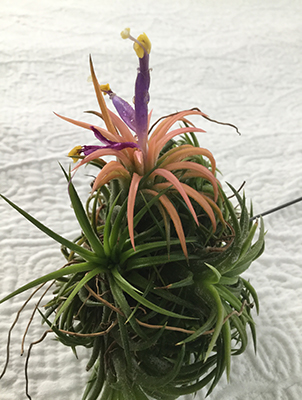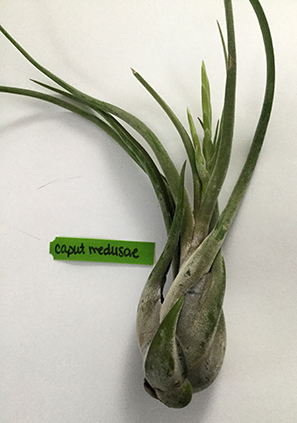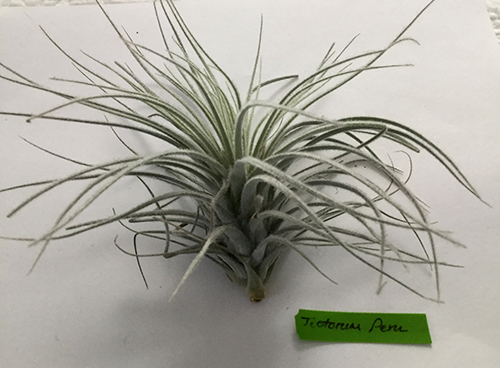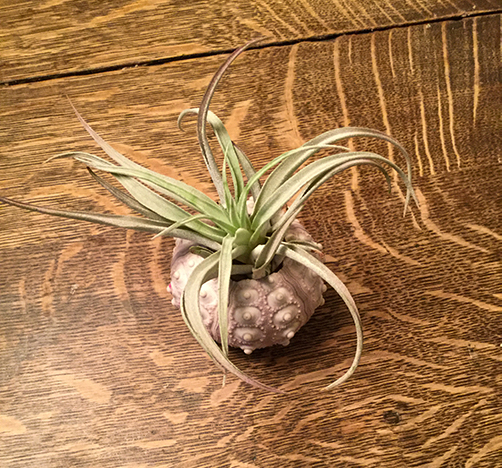Story and photos by Carol Ann Harlos
You probably have heard of “air plants,” or tillandsias. Tillandsias naturally grow in drier areas of the southern U.S. to parts of South America. You may have seen “Spanish moss” growing on trees (thus the term “epiphytic” meaning “on a plant”) in Florida or purchased some for use in wreath making. Spanish moss is not really a moss but one of the many species of tillandsias. Spanish moss, like all tillandsias, loves humidity and grows tiny flowers since it is an angiosperm. Tillandsias are bromeliads (related to pineapples) and are also monocots related to grasses and lilies. Tillandsias are unique as they only open their stomates (leaf pores) at night to release oxygen, the byproduct of photosynthesis. This prevents water loss that would occur in the heat of the sun. At this time they also pick up the carbon dioxide necessary for photosynthesis occurring in the daytime.
There are hundreds tillandsias that can grow without soil and require just the barest minimum of care. Tillandsias absorb water through their leaves through hair-like structures called trichomes. Those commonly grown in homes are often called “aerophytes,” as they seem to live on air. The form of all tillandisas is really some type of rosette made up of overlapping leaves which accumulate dust particles. In a home these might include skin cells, hair, pet dander, bacteria, dust mites, bits of dead bugs, soil particles, and pollen. These make up the nourishment needed by the plants. The minute roots serve as anchors instead of absorbing water. (This is important as I have met people who killed their tillandsias because they soaked the roots which subsequently rotted!) I have tillandsias in both north and south windows. They thrive in both. The light is bright and the temperature changes little, which makes them quite happy.
The pictures included in this article are some of the author’s tillandsias. The one tucked into a sea urchin shell. Tillandsia harrisii, which originated in Guatemala, has doubled in size since it was purchased. It lives on a shelf in a northern window.
The T. ionantha ball is made of several tillandsias wired together. The ball thrives in the south window of a bathroom. Since I love warm showers I rarely water them. Several of the plants in the ball have flowered, a thrill to the author! In Guatemala the bright red flowers attract hummingbirds leading to pollination and seed formation. Since tillandsias are not self-fertile, this did not occur in my home. Only mature plants flower. Pups (offshoots) form at the base of the “mother” plant after blooming finishes. The offspring then are clones of the parent plant.

T. caput x brachycaulos, T. caput-medusae, and their crosses are often called “octopus plants” or “medusa’s head.” They have rather thick, twisted leaves that grow from a “pseudobulb”… it looks like a bulb but isn’t. It is said to bloom red. Mine have yet to bloom.


T. tectorum is native to Ecuador and Peru. In nature it is found on cliff faces. This tillandsia has a more open form than the ones mentioned above. I find it needs less care than the other tillandsias, probably because it had to adapt to a tough dry sunny environment in the wild. They seem to thrive in direct light in my home and require far less water to survive.

Although Tillandsias are easy-care plants, all tillandsias don’t require the same care so pay attention to how the plants look … shrunken, browning, losing leaves, or firm. Some plants are thin, others fleshy. This affects their need for water. I soak my Tillandsias in a bowl of water periodically for a few minutes or run tap water over them. If your tillandsias look shrunken simply soak them longer. Some people use dechlorinated water but I never have. Take your cue from your tillandsias as you would any other plants. When I think of it I use a very dilute fertilizer in the water. That’s it!
Many people place tillandsias in glass jars by themselves as they are architecturally intriguing. It is easier to simply mist these once in a while since putting them directly in water may be inconvenient. I have also seen tillandsias tucked into a pot containing entirely different types of plants simply for adding interest.
Carol Ann Harlos is an Erie County Master Gardener.
Views: 0







